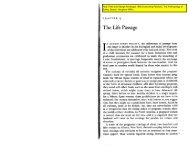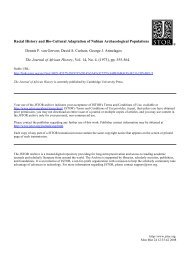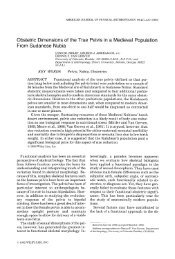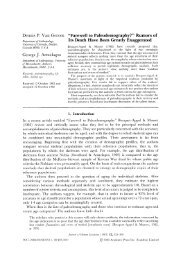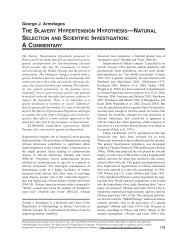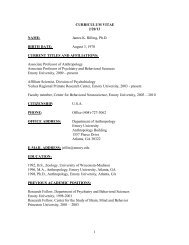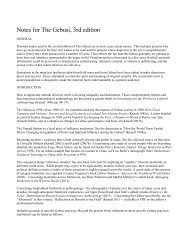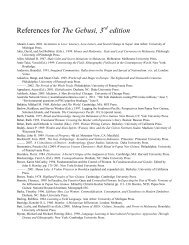The Gebusi, 3rd ed. Study Questions - Anthropology
The Gebusi, 3rd ed. Study Questions - Anthropology
The Gebusi, 3rd ed. Study Questions - Anthropology
You also want an ePaper? Increase the reach of your titles
YUMPU automatically turns print PDFs into web optimized ePapers that Google loves.
<strong>Study</strong> <strong>Questions</strong><br />
for <strong>The</strong> <strong>Gebusi</strong>, Third Edition<br />
Introduction: In Search of Surprise<br />
A. In what ways is being surpris<strong>ed</strong> a good or a necessary feature of being a social and cultural<br />
anthropologist?<br />
B. During what three time periods did the author study with the <strong>Gebusi</strong>? What general patterns of<br />
social change are describ<strong>ed</strong> across these times?<br />
C. What does the author say about the appreciation of cultural diversity and the critical exposure of<br />
human inequality and domination? What does he assert about the relationship between these aspects of<br />
culture in anthropology? In thinking about your own culture, do you agree or disagree with his point of<br />
view, and why?<br />
FOR ADVANCED STUDENTS:<br />
A. What are the theoretical and historical underpinnings of anthropology’s “appreciation of<br />
cultural diversity” and it’s “critique of inequality.” Arguably, the first of these has been<br />
stronger in anthropology’s earlier history – and continues to distinguish anthropology from<br />
other social sciences – while the latter has becoming increasingly important since the 1960s.<br />
Why is this so?<br />
B. What ways can be found, analytically, theoretically, and ethnograpically, to cross-cut, m<strong>ed</strong>iate<br />
or “articulate” the strains of cultural appreciation and critical exposure that are characteriz<strong>ed</strong><br />
as discrete or complementary points of view in this chapter?<br />
C. How can the “surprise” of contemporary situations and more familiar cultures be more<br />
effectively includ<strong>ed</strong> and communicat<strong>ed</strong> in anthropology to keep the field both up to date and<br />
of value and interest to students?<br />
Chapter 1: Friends in the Forest<br />
A. How did the author come in contact with the <strong>Gebusi</strong>? How were he and his wife treat<strong>ed</strong> at the<br />
beginning? In what ways was it challenging for them to learn the <strong>Gebusi</strong> language?<br />
B. How were the lives of <strong>Gebusi</strong> shap<strong>ed</strong> by the neighboring B<strong>ed</strong>amini people, on the one hand, and<br />
intervention by Australian colonial officers, on the other?<br />
C. What is kogwayay? What does this term reflect about <strong>Gebusi</strong> culture, and why is this significant?<br />
D. What important aspects of <strong>Gebusi</strong> culture and of <strong>Gebusi</strong> gender relations were downplay<strong>ed</strong> or<br />
cover<strong>ed</strong> up by emphasis on kogwayay? What do these patterns reveal about the use of culture in general?
FOR ADVANCED STUDENTS:<br />
A. What is the relationship between reciprocity and exchange among the <strong>Gebusi</strong> and between<br />
them and the author himself? Are these the same? Why or why not? Bas<strong>ed</strong> on other<br />
ethnographies you have read, what similarities and differences are there both between patterns<br />
of social reciprocity in soceities AND between members of these societies and the<br />
anthropologists who have studi<strong>ed</strong> them?<br />
B. What is the rhetorical or p<strong>ed</strong>agogical status of anthropological accounts of personal “entry”<br />
into the field? What to these reveal about the status of the ethnographer as an assert<strong>ed</strong> “eyewitness”<br />
and about the receiv<strong>ed</strong> tropes of romantic encounter in ethnographic fieldwork?<br />
How could accounts of fieldwork “entry” be made analytically and theoretically salient for<br />
advanc<strong>ed</strong> students and academics as well as for beginning students?<br />
C. What notion and understanding of “culture” informs the author’s analysis? Critiques of the<br />
classic anthropological notion of “culture” (for instance, as propound<strong>ed</strong> by Clifford Geertz<br />
and others) include objections that such attributions of “culture” are (a) too systemic or<br />
systematic (b) too objectivist (c) not fully shar<strong>ed</strong> among the members of the culture (d) too<br />
fix<strong>ed</strong> or bound<strong>ed</strong> in space and place by anthropological attribution. To what degree do these<br />
objections also pertain, or not, to the author’s implicit notion of <strong>Gebusi</strong> “culture”? In what<br />
ways would a different conceptualization of culture alter, improve—or compromise—the<br />
author’s account?<br />
Chapter 2: Rhythms of Survival<br />
A. Describe the connection between sharing and the making of social relationships in <strong>Gebusi</strong> society.<br />
Give specific examples of <strong>Gebusi</strong> gift giving. In what ways were the resulting relationships similar to or<br />
different from those in your own society?<br />
B. What do <strong>Gebusi</strong> eat? How do they make their houses? Across the spectrum of human subsistence<br />
patterns, what type of subsistence and of residential organization do <strong>Gebusi</strong> exhibit most strongly?<br />
C. How would you describe the physical environment and health situation of the <strong>Gebusi</strong>? In what<br />
ways were conditions of environment and health experienc<strong>ed</strong> similarly or differently by <strong>Gebusi</strong>, on the one<br />
hand, and the author, on the other?<br />
D. In what way are <strong>Gebusi</strong> “in-betweeners,” and what does this reveal about the use of concepts in<br />
social and cultural anthropology?<br />
FOR ADVANCED STUDENTS:<br />
A. What are the benefits and difficulties of isolating and categorizing “subsistence” or<br />
“livelihood” as an anthropological category of analysis as oppos<strong>ed</strong> to a more ramifi<strong>ed</strong>
analysis of social relations?<br />
B. What implications and comparative significance does the “mix<strong>ed</strong>” nature of <strong>Gebusi</strong><br />
subsistence – horticulture with some foraging, s<strong>ed</strong>entism with some nomadism, and son<br />
on – have for the concepts and analysis of material cultural evolution and types of human<br />
society in a broader sense.<br />
C. From a demographic perspective, why do you think the <strong>Gebusi</strong> were not more highly<br />
populat<strong>ed</strong>? If you were a fieldworker, either at the time or retrospectively, how would<br />
you begin to empirically investigate which of the following was most important in<br />
explaining <strong>Gebusi</strong>’s low population density: (a) human pr<strong>ed</strong>ation (e.g., from the<br />
B<strong>ed</strong>amini) (b) disease risk factors (exposure to malaria in the deep forest) (c) protein<br />
insufficiency.<br />
D. What further information would you like to know about <strong>Gebusi</strong> subsistence regimes, and<br />
what significance would such information potentially have in comparative terms?<br />
Chapter 3: Lives of Death<br />
A. Describe key features of Dugawe’s death, his funeral, and the investigation that result<strong>ed</strong>. Reflect<br />
on how you would have or might have react<strong>ed</strong> to these events.<br />
B. Summarize key features of <strong>Gebusi</strong> sorcery beliefs and practices. Describe how beliefs and<br />
practices concerning sorcery affect <strong>Gebusi</strong> responses to death.<br />
C. In what ways did events concerning the death of Dugawe and the fate of Sialim reflect general<br />
features of <strong>Gebusi</strong> culture? In what ways were these events distinctive or even unique?<br />
D. What does the author say about the experience of fieldwork in relation to establishing<br />
ethnographic facts and making generalizations?<br />
FOR ADVANCED STUDENTS:<br />
A. As a prospective ethnographer, what further questions would you ask about the life stories and<br />
events surrounding, and prec<strong>ed</strong>ing, Dugawe’s suicide? How would you go about answering<br />
these?<br />
B. How bit a role do you think Bruce’s own presence had in forestalling <strong>Gebusi</strong> violence against<br />
Sialim? More generally, what impact do you think his presence had – or didn’t have -- in<br />
shaping the unfolding of events?<br />
C. With benefit of hindsight, do you think Bruce’s ethics of fieldwork practice were sound in his<br />
approach to “observing” and to some extent “participating” in <strong>Gebusi</strong> sorcery inquests? What<br />
changes if any would you have made? And what difference would these have made in the<br />
progress – or limitation – of the remainder of his fieldwork?<br />
D. Examine the account of another complex or interesting “ethnographic story” in another book.<br />
Bas<strong>ed</strong> on the “chaos of discovery and interpretation” as describ<strong>ed</strong> in this chapter, how would
you re-think or reevaluate the ethnographic account you have chosen for consideration?<br />
Chapter 4: Getting Along with Kin and Killers<br />
A. Describe <strong>Gebusi</strong> kin groups, the role of clans and lineages, and the composition of <strong>Gebusi</strong><br />
settlements.<br />
B. What types of marriage are characteristic of <strong>Gebusi</strong>, and how do they relate to <strong>Gebusi</strong> patterns of<br />
kinship, exchange, and reciprocity? What structural tensions or fault lines result from marriages that are<br />
“romantic” in nature and not reciprocat<strong>ed</strong>? What connections are there between <strong>Gebusi</strong> sorcery accusations<br />
and their patterns of marriage and social organization?<br />
C. Describe the pattern and degree of violence and homicide among <strong>Gebusi</strong> as describ<strong>ed</strong> in this<br />
chapter. How did the <strong>Gebusi</strong> rate of killing compare with that in other societies and cultures? Does an<br />
understanding of <strong>Gebusi</strong> violence suggest anything about the causes and conditions of violence elsewhere?<br />
D. For <strong>Gebusi</strong> and more generally, what is the value of social organization and kinship for<br />
understanding problems and tensions that societies face? How does the study of social organization help<br />
uncover the variable relationship between what people say or believe and what they actually do?<br />
E. According to the author, what place is there in anthropology for structural or statistical depictions<br />
of social behavior? What is the proper relationship between these depictions and the more nuanc<strong>ed</strong> and<br />
humaniz<strong>ed</strong> description of specific events and people?<br />
FOR ADVANCED STUDENTS:<br />
A. Do the various aspects of the author’s analysis of <strong>Gebusi</strong> social organization, and its relation<br />
to their violence, all make sense to you? What questions or “leaps of fact or inference” do<br />
you think the author makes? For instance, are the details of B<strong>ed</strong>amini-perpetrat<strong>ed</strong> violence<br />
adequately consider<strong>ed</strong>? Is the disjunction between “direct reciprocity in marriage” and the de<br />
facto acceptance of non-reciprocal marriage make sense to you? (See Knauft, Good Company<br />
and Violence, U California Press, 1985, for more details).<br />
B. How and why do you think <strong>Gebusi</strong> contrast to the patterns of social organization – and<br />
collective warfare – attribut<strong>ed</strong> to many tribal peoples, including those describ<strong>ed</strong> for parts of<br />
the New Guinea highlands?<br />
C. Do you think the study of social organization and kinship in relation to violence is also<br />
applicable to more complex society environments – contemporary towns and cities – or<br />
moreso mostly in “tribal” societies such as <strong>Gebusi</strong>? In what ways could our understanding of<br />
social organization and kinship be improv<strong>ed</strong> to make it more germane to understanding<br />
contemporary conflict and violence patterns more generally?<br />
D. In what ways is the account of social conflict or violence in other anthropological or<br />
ethnographic accounts – including concerning more recent or widespread social problems –<br />
link<strong>ed</strong> or linkable to patterns of social organization in relation to local or regional political
economy? More generally, in what ways is the kind of analysis propos<strong>ed</strong> in this chapter<br />
useful, or not, for the study of other and potentially broader human conflicts and problems?<br />
Chapter 5: Spirits, Sex, and Celebration<br />
A. According to the author, what are some of the important reasons why sexual culture is a valid and<br />
significant topic of study for anthropologists? What does the author’s experience reveal about the potential<br />
benefits—and risks—of investigating sexual beliefs and practices in another culture?<br />
B. Describe the shifting sexual practices of <strong>Gebusi</strong> males from early adolescence to middle age as<br />
describ<strong>ed</strong> for 1980–82. What role do spiritual beliefs play in influencing their sexual orientations and<br />
practices?<br />
C. Do you think <strong>Gebusi</strong> men are in fact more strongly attract<strong>ed</strong> sexually to other men, or to women?<br />
What evidence could you use to support your claim either way?<br />
D. Describe the attitude and orientation of <strong>Gebusi</strong> women concerning: (a) their own heterosexual<br />
relations with men, (b) men’s sexual relations with each other, (c) men’s ritual representation of female<br />
sexuality and of spirit women, and (d) the potential for sexual relations between <strong>Gebusi</strong> women themselves.<br />
E. In what ways are <strong>Gebusi</strong> sexually tolerant? In what ways are they restrictive or conservative? Do<br />
women enjoy the same degree of sexual toleration or restriction as men? Why or why not, and under what<br />
circumstances?<br />
F. What do the <strong>Gebusi</strong> illustrate about the nature of human gender and sexuality generally?<br />
FOR ADVANCED STUDENTS:<br />
A. In what ways does the sexual diversity of <strong>Gebusi</strong> reaffirm, or undercut, the notion of Gilbert<br />
Herdt and others that “Third Sex” and “Third Gender” categories are common if not typical<br />
across human societal and cultural variation? In what ways does nominating a sexual pattern<br />
as a “third” type – or even as “homosexual,” undermine the multiplicity of sexual orientations<br />
and behaviors?<br />
B. In their book “Taboo,” Kulick and Willson explore the relevance of the sexual subject<br />
position of the anthropologist. If the present author had been “gay,” what difference would<br />
this have made, or not (a) in chapter 5 of “<strong>The</strong> <strong>Gebusi</strong>,” (b) in the remainder of the book,<br />
concerning other topics<br />
C. In what ways could the author have extend<strong>ed</strong> or further pursu<strong>ed</strong> the investigation of <strong>Gebusi</strong><br />
sexuality and gender; what further questions remain unask<strong>ed</strong> or unanswer<strong>ed</strong>? And what<br />
theoretical formulation/s – queer theory, third wave feminism, standpoint theory, postmodern<br />
sexuality, or other, would best inflect this investigation. As it is, the author’s own theoretical<br />
assumptions in examining sexuality are largely implicit or unexpress<strong>ed</strong> for this undergraduate<br />
audience? What are the strengths and weaknesses of this – and what are the alternatives?
Chapter 6: Ultimate Splendor<br />
A. Summarize the basic sequence of <strong>Gebusi</strong> initiation activities—what comes first and what comes<br />
next. Describe the ways that <strong>Gebusi</strong> from different settlements are thereby brought together.<br />
B. <strong>The</strong> author states that <strong>Gebusi</strong> initiations combine (a) spirituality, (b) sexuality, (c) material gifts<br />
and exchanges, (d) kinship, (e) friendship, and (f) gender. Identify a key example of each of these features<br />
in the <strong>Gebusi</strong> initiation, and describe its connection to the other features.<br />
C. What do you think the experience would be like to be initiat<strong>ed</strong> as a young <strong>Gebusi</strong> man? What parts<br />
of this process do you think would be most enjoyable and which most difficult?<br />
D. What prevent<strong>ed</strong> the climactic celebrations of the <strong>Gebusi</strong> initiation as describ<strong>ed</strong> from going<br />
forward smoothly? How did <strong>Gebusi</strong> react to this problem—and what did their reaction reveal about <strong>Gebusi</strong><br />
culture?<br />
E. What special role did women play at the final conclusion of the initiation festivities—and what<br />
was significant about their concluding roles? In what way did this “final act” of the initiation change your<br />
view of the entire event—or not?<br />
FOR ADVANCED STUDENTS:<br />
A. Since 1981, many accounts of ritual transition in contemporary or alter<strong>ed</strong> context have been<br />
publish<strong>ed</strong>, including for Africa and other world areas, that include more modern social, political,<br />
economic, and cultural influences. In what ways could these have been us<strong>ed</strong> to broaden to expand<br />
the author’s account of <strong>Gebusi</strong> initiation even in 1981?<br />
B. What aspects of ritual exchange, social relations, and cosmological and/or gender<strong>ed</strong>/sexual<br />
experience would you like to know more about concerning <strong>Gebusi</strong> ritual initiation? How would<br />
you (or would you have) been able to investigate these? Do you agree with the author’s conclusion<br />
about the relative role and significance of young men and young women in the initiation? What<br />
more could have been investigat<strong>ed</strong> in this regard?<br />
C. Compare this chapter with Edward Schieffelin’s book, <strong>The</strong> Sorry of the Lonely and the Burning of<br />
the Dancers.” What are the strengths and limitations, respectively, of each account – and why?<br />
Chapter 7: Time for Change: Yuway’s Sacr<strong>ed</strong> Decision<br />
A. Describe how changes in anthropology—and changes in the author’s own circumstances and<br />
disposition—affect<strong>ed</strong> his expectations and initial experiences among the <strong>Gebusi</strong> in 1998.<br />
B. What general features, according to the author, are associat<strong>ed</strong> with being or becoming “modern”?<br />
Which specific new activities and institutions were associat<strong>ed</strong> with becoming modern for the people of<br />
Gasumi Corners in 1998?<br />
C. How did <strong>Gebusi</strong> notions and experiences of time change between 1980 and 1998? What examples
does the author provide to illustrate these changes? Why are changes in <strong>Gebusi</strong> notions of time significant?<br />
D. What factors help account for the fact that <strong>Gebusi</strong> so willingly accept<strong>ed</strong> modernizing influences<br />
between 1982 and 1998? How much of this acceptance was bas<strong>ed</strong> in factors of culture or belief rather than<br />
actual economic improvement?<br />
E. By what means had <strong>Gebusi</strong> become Christian by 1998? What was the respective role of (a) white<br />
missionaries, (b) Papua New Guineans from other parts of the country, (c) cultural beliefs and orientations<br />
to modernity, (d) the prospect or lure of material rewards, and (e) the decisions and actions of <strong>Gebusi</strong><br />
themselves?<br />
F. Why did Yuway choose to become a member of the Seventh Day Adventist Church (SDA)? What<br />
does his choice reveal about local perceptions of different Christian churches, and about the extent of<br />
<strong>Gebusi</strong> religious fre<strong>ed</strong>om?<br />
G. What has been the relationship between Christianity and sorcery violence among <strong>Gebusi</strong> over<br />
time? In what ways is the impact of Christanity upon <strong>Gebusi</strong> sorcery evident in (a) the life story of<br />
Doliay—the man who behead<strong>ed</strong> a <strong>Gebusi</strong> as a sorcerer in 1988, and (b) the death and funeral of Uwano in<br />
1998?<br />
H. <strong>The</strong> author suggests that Christianity among <strong>Gebusi</strong> in 1998 was link<strong>ed</strong> with politics, government,<br />
and desires to be or become modern. What evidence is us<strong>ed</strong> to support this claim?<br />
I. What does the author assess as the cost and the benefit of Christianity among <strong>Gebusi</strong> relative to<br />
their traditional spiritual beliefs and practices? What is your own opinion, and why?<br />
FOR ADVANCED STUDENTS:<br />
A. What literary or rhetorical tropes of “reentry” does the author use to frame this chapter? What<br />
kinds of romanticism (or critical objectivism) are deploy<strong>ed</strong>, and to what effect?<br />
B. Authors such as Reinhart Koselleck (for instance, in his book Futures Past) have suggest<strong>ed</strong><br />
that modernity is underpinn<strong>ed</strong> by new senses of ever-unfolding progressiveness in time or<br />
temporality. In what ways is the <strong>Gebusi</strong>’s emergent sense of time as describe in this chapter<br />
consistent with this view.<br />
C. What underpins the author’s understanding of being “modern” or engaging with “modernity.”<br />
How could his assumptions be made more explicit—or improv<strong>ed</strong> upon? (See Knauft,<br />
Critically Modern, U Chicago Press, 2002).<br />
D. What is significant about <strong>Gebusi</strong> conversion, and Yuway’s individual conversion, in the wider<br />
context of the spread of world religions and of fundamentalist Christianity in particular? Do<br />
these changes among Gebuis confirm or disconfirm Joel Robbins’ suggestion that evangelical<br />
Christianity is largely refractory to syncretism and nuanc<strong>ed</strong> combination with non-Christian<br />
religious forms; that is it pr<strong>ed</strong>icat<strong>ed</strong> on Manichean oppositionalism?<br />
E. Does it change your understanding or interpretation of this chapter to know that Yuway gave
up Seventh Day Adventism between 1998 and 2008? How so?<br />
Chapter 8: Pennies and Peanuts, Rugby and Radios<br />
A. How successful were <strong>Gebusi</strong> women in selling goods at the Nomad Market in 1998? Describe the<br />
cultural as well as the economic features of the Nomad market—and how these help explain the continuing<br />
participation of women.<br />
B. Describe Nolop’s achievements and challenges in life, and reflect on her status in <strong>Gebusi</strong> society.<br />
C. How was the author able, as a man, to obtain information in direct conversation with <strong>Gebusi</strong><br />
women? Describe the opportunities or constraints that you think you yourself would face, given your<br />
gender and disposition, in engaging the lives of <strong>Gebusi</strong> men and women.<br />
D. How did Nomad school children envisage their future lives in 1998, and what were the differences<br />
between boys and girls in this regard? Why is this significant?<br />
E. What difficulties had arisen at the Nomad Station by 1998 due to increasing or inflat<strong>ed</strong><br />
expectations of future success? What differences are there between young men and women in this regard,<br />
and how do these differences appear to affect gender relations?<br />
FOR ADVANCED STUDENTS:<br />
A. Many ethnographic studies from Africa and elsewhere highlight the significant that women<br />
play in non-corporate market activity in major town and urban centers. Why and how do you<br />
think this is the case—and does this undercut or confirm assertions that globalization tends to<br />
benefit men, on the whole, more than it does women?<br />
B. In what ways is <strong>Gebusi</strong> women’s market activity in fact “irrational” or not? What kinds of<br />
cultural assertions, and conceptual definitions, would you make to adjudicate—or to reframe—this<br />
question.<br />
C. <strong>Gebusi</strong> schooling evokes the “diploma disease” in many developing countries, in which those<br />
who graduate are often unemploy<strong>ed</strong> – and over<strong>ed</strong>ucat<strong>ed</strong> for the jobs that they can get, and<br />
which they find meaningful. Do you think this is also true for <strong>Gebusi</strong>, or not, given that they<br />
have little market economy to begin with? What larger issues – theoretically, and<br />
comparatively concerning cultural context--are it stake in addressing this question?<br />
Chapter 9: Mysterious Romance, Marital Choice<br />
A. What does the story of Wayabay reveal about (a) new ways of finding a bride in Gasumi Corners,<br />
(b) changes in <strong>Gebusi</strong> sexual orientations and practices, and (c) the challenges of communication across<br />
cultures?<br />
B. What does the story of Gami illustrate about (a) changing patterns of <strong>Gebusi</strong> sister-exchange, (b)
the ability of <strong>Gebusi</strong> women to make their own marital choices, and (c) the dilemma fac<strong>ed</strong> by outsiders<br />
such as anthropologists when they try to help local people?<br />
C. Bas<strong>ed</strong> on the stories of Wayabay and Gami, what guidelines do you think would r<strong>ed</strong>uce the<br />
chances that well-intention<strong>ed</strong> attempts by outsiders to help local people will fail or be counter-productive?<br />
D. Describe changes in marital choices and in marital risks as experienc<strong>ed</strong> by young people in<br />
Gasumi Corners. In your own opinion, among <strong>Gebusi</strong> and in your own culture, is there any potential<br />
benefit to trying to r<strong>ed</strong>uce rather than maximize the number of people from whom one might choose a<br />
partner?<br />
FOR ADVANCED STUDENTS:<br />
A. What is the relationship between Wayabay’s case and that of Gami? Are they complements,<br />
or part of the same pattern? Given their histories, would you guess Wayabay’s concluding<br />
marriage to Gami would be compatible and “companionate,” or not? In what ways do the<br />
accounts and insights of work on modern ideals of companionate marriage, for instance, as<br />
analyz<strong>ed</strong> by Jennifer Hirsch, Holly Wardlow, and others in their recent books and articles,<br />
influence your answers to this question?<br />
B. What difference – analytically and in terms of ethnographic terms of understanding—does it<br />
make if Wayabay, Didiga, and Sayu did not “know” about <strong>Gebusi</strong> male-male sexuality? Does<br />
it seem that they were concen<strong>ed</strong> about this – or was it merely the preoccupation of the author<br />
himself with <strong>Gebusi</strong> male-male sexuality that makes this issue relevant?<br />
C. In hindsight, how could the author have handl<strong>ed</strong> his interaction with Wayabay differently –<br />
and what difference would this have made, or potentially have made, in our understanding of<br />
<strong>Gebusi</strong> changes?<br />
D. What avenues of understanding did the author open up – and which were foreclos<strong>ed</strong> – in the<br />
way the author tri<strong>ed</strong> to intervene in Magi’s case? What further issues and questions would<br />
you like to have been rais<strong>ed</strong> in investigating the development of courtship, marital choice, and<br />
marriage among <strong>Gebusi</strong> in 1998 – and what significance would these have potentially had?<br />
Chapter 10: Sayu’s Dance and After<br />
A. What were the major stages and transitions in Sayu’s life as recount<strong>ed</strong> by the author? How would<br />
you characterize the changes and challenges of Sayu’s life up to 1998? What was the author’s history with<br />
Sayu—and his relationship with him in 1998?<br />
B. In what ways did ritual life as perform<strong>ed</strong> in <strong>Gebusi</strong> villages change between 1982 and 1998? Use<br />
Sayu’s dance and the author’s departure feast as examples.<br />
C. Summarize the basic events and activities of the Nomad Independence Day celebrations of 1998.<br />
Describe how traditions and traditional dancing were present<strong>ed</strong>—and their relationship to contemporary or<br />
modern forms of entertainment or display at Nomad.
D. What did the Nomad Independence Day celebrations reveal and reflect about (a) changes in<br />
<strong>Gebusi</strong> culture, (b) <strong>Gebusi</strong>’s relation with their ethnic neighbors, (c) <strong>Gebusi</strong> in relation to their government<br />
and the Papua New Guinea State, and (d) the general relationship between culture, ritual, and social<br />
change?<br />
FOR ADVANCED STUDENTS:<br />
A. Of what larger significance is the disjunction in tone and emphasis between Sayu’s traditional<br />
dance and the activities surrounding Independence Day at Nomad. In what ways is this<br />
disjunction objectively “ethnographic,” and to what degree is it an authorial or rhetorical<br />
artifact of the way the chapter is written? What are the stakes and issues concerning the status<br />
of “public culture” in addressing or answering this question?<br />
B. Of the many different features of Independence Day festivities at Nomad, which did you find<br />
most poignant, and why? Do you think it was successful for the author to consider them all as<br />
a polysemic tableau of the complexity of contemporary cultural life of <strong>Gebusi</strong> in and around<br />
Nomad? What does this frame of understanding cover up or elide <strong>Gebusi</strong> public culture and<br />
ceremonial life and the time – and what does it reveal?<br />
C. What analytic and theoretical dimension of “public culture” would you have us<strong>ed</strong> to<br />
complement, re-frame, or augment the author’s description of <strong>Gebusi</strong> Independence Day<br />
festivities?<br />
D. Along with the book’s final section, “Farewell,” the final celebrations surrounding Bruce’s<br />
departure in this chapter form a kind of “end narrative” that complements the “entry<br />
narrative” of the book at the beginning. In what ways are these narrative constructions similar<br />
or different, and what do they reveal about the intend<strong>ed</strong> “message” or the book as it “travels”<br />
form it’s outset to its end?<br />
Chapter 11: Revival 2008<br />
A. How difficult was it for the author to return to the <strong>Gebusi</strong> in 2008, and why? What was the larger<br />
significance of this difficulty for the Nomad area and for the <strong>Gebusi</strong>?<br />
B. What were the author’s first reactions and impressions upon returning to the <strong>Gebusi</strong> in 2008, and<br />
what did these reveal?<br />
C. List and give examples of the major features of change that the author describes for the <strong>Gebusi</strong> in<br />
2008, including (a) engagement with their physical environment, (b) population, (c) economic status, (d)<br />
government, (e) institutional religion, (f) dance and performance, (g) social etiquette, and (h) residence,<br />
community relations, and social integrity.<br />
D. Describe and draw implications from developments of the <strong>Gebusi</strong>’s local Catholic Church as<br />
portray<strong>ed</strong> for 2008.<br />
E. What is the author’s final conclusion in 2008 concerning the end point of culture change among
<strong>Gebusi</strong>? What does he assert as the meaning of his own continuing fieldwork among <strong>Gebusi</strong>?<br />
FOR ADVANCED STUDENTS:<br />
A. Using the “reinvention of culture” literature, critically reexamine <strong>Gebusi</strong> changes ala 2008.<br />
B. In this chapter, the author implies that economic downturn and restriction influenc<strong>ed</strong> the<br />
resurgence of <strong>Gebusi</strong> indigenous customs. Is this association generally true? What other<br />
stimuli or stresses may underlie cultural resurgence? Given that the author implies that<br />
culture is intrinsically creative and dynamic, does there “ne<strong>ed</strong>” ne<strong>ed</strong> to be economic or other<br />
motivation (such as political oppression) to motivate rejuvenation of cultural expressions?<br />
C. What is at stake in attributing cultural changes as a “reinvention” or culture as oppos<strong>ed</strong> simply<br />
to cultural change and development? Is this term anachronistic or subtly “primitivizing,” or is<br />
it useful and worthwhile in the present?<br />
Chapter 12: 2012 and Beyond -- and “Farewell”<br />
A. Summarize the key patterns and differences across time of <strong>Gebusi</strong> as describ<strong>ed</strong> by the author<br />
for (a) 1980–82, (b) 1998, (c) 2008 (d) late 2011. Given this sequence of changes, what future<br />
does the author pr<strong>ed</strong>ict, or not pr<strong>ed</strong>ict, for <strong>Gebusi</strong> in the future?<br />
B. Describe the political economy of the Ok T<strong>ed</strong>i mine, and its continuing impact upon <strong>Gebusi</strong>?<br />
C. What challenges face Bruce as he plans to return to the <strong>Gebusi</strong> again – and why are these<br />
significant?<br />
D. What does the author say about the reassertion or rejuvenation of customary practices? Can<br />
these ever be re-enact<strong>ed</strong> just as they were before? Conversely, can customs or practices be<br />
abandon<strong>ed</strong> and left behind with no impact at all on the present or the future?<br />
E. What key features of environmental change, and of colonialism and modernity more<br />
generally, have the <strong>Gebusi</strong> been fortunate to have avoid<strong>ed</strong>? How does their fortune in this<br />
respect impact the <strong>Gebusi</strong>’s ability to develop their own livelihood and culture?<br />
F. What is the ultimate gift that the author finds the <strong>Gebusi</strong> have given him?<br />
G. Farewell: How does the author feel when he finally leaves the <strong>Gebusi</strong>, and why? If it were<br />
you, how would you feel, and why?<br />
FOR ADVANCED STUDENTS:<br />
A. In what way could the political economy of the Western Province be us<strong>ed</strong> to re-frame the<br />
author’s understanding of the <strong>Gebusi</strong> in earlier chapters of the book? How would this have<br />
chang<strong>ed</strong> the book, potentially for the better? In the mix, how would the book have been<br />
potentially weaken<strong>ed</strong> or dilut<strong>ed</strong>?<br />
B. <strong>The</strong> <strong>Gebusi</strong> aspire to greater outside contact and influence, but significant evidence suggests<br />
this could be detrimental to their environment as well as to their cultural integrity. If you
were in a position of influence or intervention with respect to the <strong>Gebusi</strong>, what would you<br />
recommend – and how would you keep your actions from being unwittingly paternalistic or<br />
condescending.<br />
C. Why do you think that the author was apparently more successful in developing direct<br />
“engag<strong>ed</strong> anthropology” projects in other world areas, and at higher levels of influence, that<br />
he appears to have done to date among <strong>Gebusi</strong>? What are the larger stakes in this?<br />
D. What is the significance of longitudinal fieldwork over several decades given that the period<br />
of field immersion is typically shorter during later period of field engagement than at earlier<br />
career stages? What issues would a full longterm restudy of the <strong>Gebusi</strong> at the present time<br />
best address, and potentially reveal that are not fully evident in the existing account?<br />
list of persons<br />
list of persons study questions<br />
study questions study questions<br />
study questions study questions



